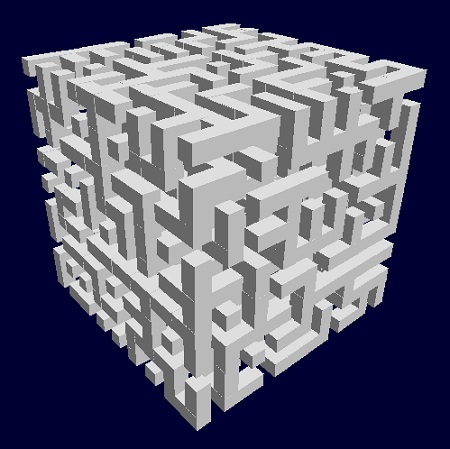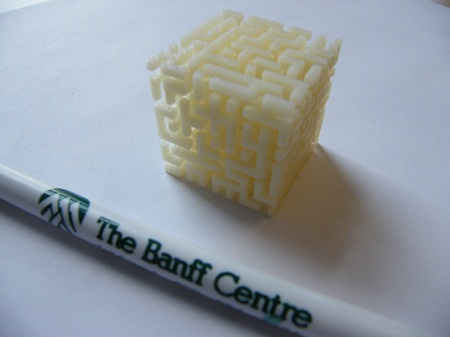Several years ago I became fascinated by 3D mazes. These are like the 2D mazes we’re all familiar with, except they form 3D paths within a cube, rather than 2D paths within a square. To explore these fascinating shapes (which look a lot like the Borg mothership), I created an interactive Java applet, which lets you create virtual objects that look like this:

As long as I am at the Banff Centre, it seemed like a good idea to print one of these things out in the real world. So I modified the Java applet to create a file that the 3D printer can read. It seemed like a good idea to print out the first one very small — you never know how safe you are with the Borg. And this is the first thing that resulted:

There is something wonderful about having one of these out in the physical world, where I can touch it and hold it in my hand. It’s a much more visceral experience than merely looking at an image on a computer screen.
As usual, I’ve included the trusty Banff Centre pen, to give you a sense of scale. I must say I am rather pleased. Now I’m trying to decide which of my Java creations to next bring out into our physical world.
I am open to suggestions. 🙂
It appears that most of the 3D printed objects so far have smooth and low frequency geometry. I would be very interested to see if it is possible to print high frequency details, e.g. the nice looking fur-ball hyper-texture on http://mrl.nyu.edu/~perlin/doc/hypertexture/ or some hair geometry.
More specifically, all these 3D printers (just like all display devices) have a limited resolution, so your posts made me think about how to properly perform anti-aliasing. There are known good mechanisms for traditional 2D displays, but I am not sure if they are applicable to 3D printers.
By gradually increasing the (texture) frequency bands the 3D printer will eventually fail to reproduce the object faithfully. It can be fun to find out how the (aliasing) failures will look like, and how to perform proper pre-filtering of the geometry so that the printed object resemble the original design as much as possible.
(I admit that I like to try break things, but I guess that’s part of the job function of being a computer scientist. ;-D